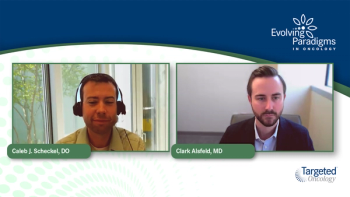
Optimal Second-Line Therapy for Diffuse Large B-Cell Lymphoma
Daniel O. Persky, MD, reflects on a patient’s relapse with diffuse large B-cell lymphoma and the rationale behind treatment with polatuzumab + BR.
Daniel O. Persky, MD: What are the NCCN [National Comprehensive Cancer Network] guideline recommendations for patients who have relapsed? [Regarding] second-line treatment for patients such as ours in this case with relapsed/refractory [R/R] diffuse large B-cell lymphoma [DLBCL], I think a common definition for refractory lymphoma is either [a] lack of complete response upon completion of first-line therapy or relapse within 6 months of completion of first-line therapy. In the case of our patient, it’s a little bit further out, meaning 9 months as opposed to within 6 months. Generally speaking, the relapses that occur within the first year have worse outcomes. As a percentage, I would say, probably about 30% to 40% of patients relapse after frontline treatment, and about 5% to 10% of patients are refractory.
There are many considerations in second-line treatment of patients with R/R DLBCL. Just like in the case of this patient, the first real consideration is whether the patient is eligible for high-dose chemotherapy, followed by autologous stem cell transplant. Important factors going into that decision include: physiologic age and comorbidities, as well as availability of a stem cell transplant facility. A lot of outpatients, probably the majority, are actually not eligible for autologous stem cell transplantation based on those factors. Just like in the case of this patient, there have been several options, including some newer options with polatuzumab combined with bendamustine and rituximab. Of course, there are some older options available as well, such as platinum-based chemotherapy in combination typically with rituximab.
For example, NCCN guidelines describe the use of gemcitabine and oxaliplatin, but there are other platinum agents used. In my practice, I typically do not use platinum-based chemotherapy as much in my nontransplant-eligible patients. Because they’re older, I’ve seen a lot of issues with toxicities, such as renal insufficiency, neuropathy, [and] changes in hearing, particularly with cisplatin. In the past, I often used actually the cell of origin to direct my next line of therapy in the setting. But with the approval of such agents as polatuzumab in combination with bendamustine and rituximab, it’s become a bit less important. Although, one could argue probably it still is important. There are also other available therapies at this point in time. There is tafasitamab and lenalidomide, selinexor, and loncastuximab tesirine.
Let’s discuss the use of polatuzumab in combination with BR [bendamustine and rituximab] in this patient, which I think was a very reasonable choice. Polatuzumab is an antibody-drug conjugate that uses a monoclonal antibody against CD79b in a covalent bond with mitotic poison, monomethyl auristatin E. This drug has a novel mechanism of action, and CD79b is a molecule that’s part of the B-cell receptor. Therefore, that’s the signal it goes through and gets internalized, and then the payload disassociates and kills the lymphoma cells.
The rationale for that combination came from the preclinical studies showing synergy with BR. BR is generally speaking, [a] reasonably well-tolerated combination of a chemotherapy agent with a monoclonal antibody, rituximab. However, by itself, BR is associated with fairly short PFS [progression-free survival] in relapsed DLBCL, typically on the order of 2 to 3 months. The fact that polatuzumab with BR works both for germinal center and nongerminal center [non-GC] derived DLBCL is significant because it makes not knowing the cell of origin necessarily less important. You know that the drug will work for both. Although to be honest, if you look numerically, the response rates are higher for non-GC DLBCL.
This transcript has been edited for clarity.








































